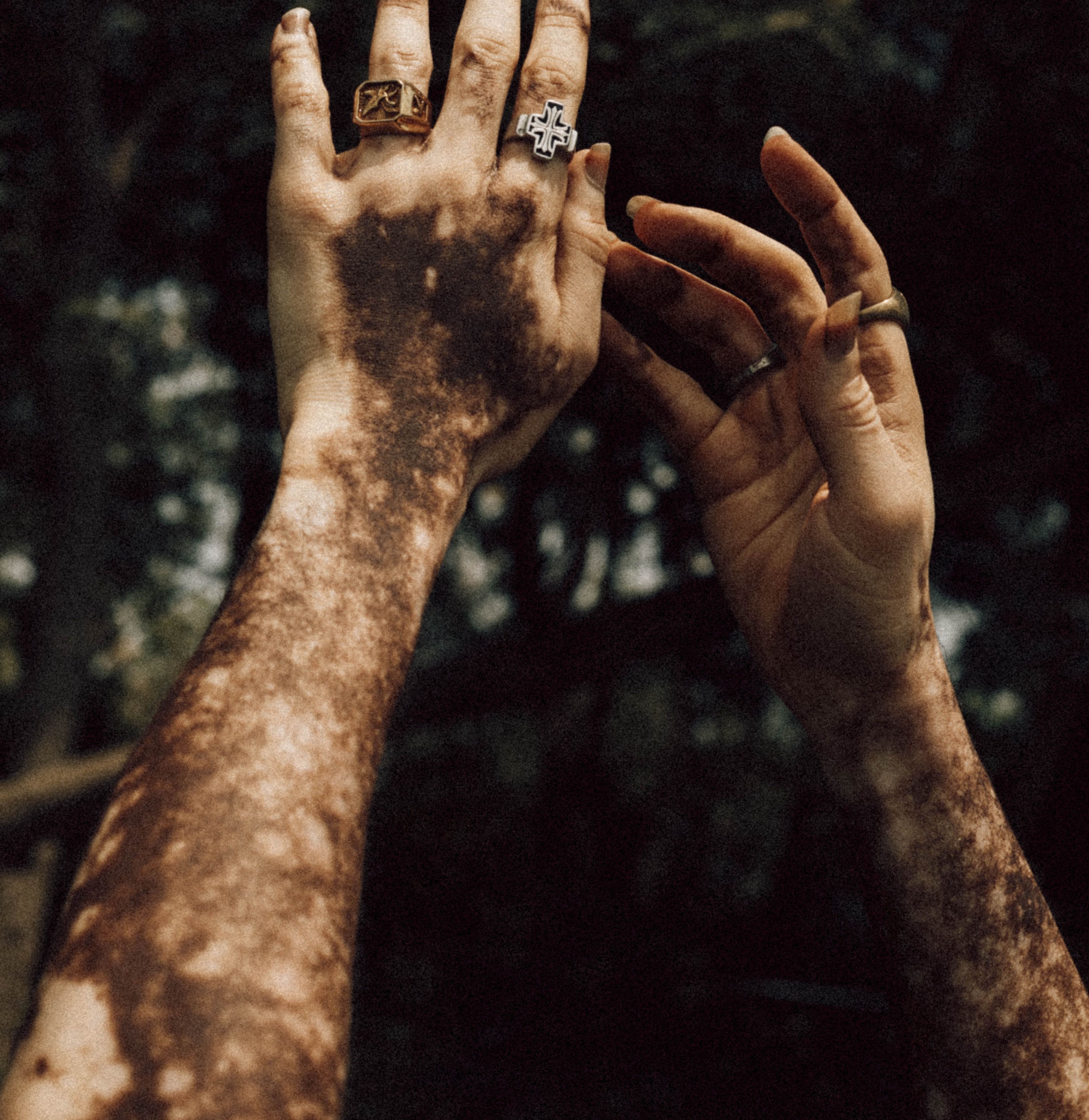
How To Keep Your Vitiligo Sun-Safe With Mineral SPF
Vitiligo skin is more susceptible to damage from the sun. Learn how to protect it with the right SPF sunscreen to feel more confident.
By Valerie George | 8 Min. Read
January 5, 2023While everyone should practice sun safety, those impacted by vitiligo need to take extra precaution when being exposed to sun’s ultraviolet (UV) rays.
Skin normally contains a pigment called melanin that acts as a natural sun protectant for skin. With vitiligo, the body’s immune system attacks melanin-producing cells, so they can’t produce melanin. This leaves unpigmented patches of skin. These light-colored patches are not only sensitive to the sun but leave the individual at higher risk for skin-related diseases like skin cancer. Individuals with vitiligo often ask, “How can I protect my vitiligo from the sun?” Fortunately, there are a few easy, stress-free ways to do this, including selecting the right sunscreen for vitiligo. With the right sun protection, those affected can feel more confident that their skin is cared for.

Choose physical over chemical sunscreens
There are two primary sunscreen categories on the market: those with physical UV blockers and those with chemical UV filters. Understanding the difference between these two types will help you make the best choice for protecting your skin.
Physical sunscreens, also called inorganic or mineral sunscreens, work by physically blocking and scattering the sun’s UV rays. These products contain physical particles called mineral oxides that shield the skin, such as zinc oxide or titanium dioxide. On the contrary, chemical sunscreens are formulated with synthetic chemical compounds, like avobenzone or homosalate. These molecules absorb ultraviolet light from the sun in order to protect the skin from UV rays, a reaction that generates small amounts of heat on skin. Whether we’re talking about physical or chemical sunscreen active ingredients, we’ll refer to all of these as filters.
While the best sunscreen for vitiligo is one you will wear religiously, choosing a mineral sunscreen is a smarter choice to protect skin. Chemical filters are designed to react with ultraviolet rays from the sun, which may cause irritation or adverse reactions on skin.1 Some chemical filters, like avobenzone, are notoriously unstable once they encounter UV light and require additional chemical stabilizers to prevent degradation. Chemical sunscreen formulations are resultantly pretty complex. On the other hand, physical sunscreen filters are both chemically and biologically inactive, so they are unlikely to cause irritation. In fact, they are very gentle on skin—zinc oxide is even approved by the FDA as a skin protectant.
Wear broad spectrum sunscreen
You may have seen the term “broad spectrum” written on a sunscreen bottle and wondered what it meant. The sun produces three types of UV rays: UVA, UVB and UVC. UVA rays are the longest of the sun’s rays and are responsible for aging skin. UVB rays are shorter in wavelength than UVA rays and are responsible for damaging our cell’s DNA. UVB rays also cause the signature red burn on skin that sun exposure leaves behind. UVC rays are filtered out by the Earth’s atmosphere, so we don’t have to worry about those.
A broad spectrum sunscreen protects skin from both UVA and UVB rays, whereas a sunscreen that is not rated broad spectrum only protects from UVB rays. What makes a sunscreen broad spectrum or not? The types of sunscreen filters used. Zinc oxide is considered a broad spectrum sunscreen filter because it protects skin from both UVB and UVA rays. For example, since SunsolveMD Calming Mineral SPF50 uses zinc oxide, it is rated a broad spectrum sunscreen. Getting adequate protection from a broad spectrum sunscreen is important because both UVA and UVB rays contribute to skin cancer, in addition to causing premature aging or burning, respectively.
Select a sunscreen with SPF 50
For as many types of physical and chemical sunscreens on the market, there are equally as many SPF values to choose from. SPF stands for “sun protection factor” and is the ratio of UVB light required to produce a sunburn on sunscreen-protected skin, compared to unprotected skin. (SPF doesn’t take into consideration UVA protection, which is why choosing a sunscreen labeled broad spectrum is an additional and separate consideration.)
For example, SPF 15 only allows 1/15th of UVB rays to reach skin, compared to skin that’s not protected. This means 1/15th, or 6.67% of sun’s rays reach sunscreen-wearing skin, as opposed to 100% of rays reaching unprotected skin. Likewise, an SPF 50 sunscreen only allows 1/50th, or 2%, of UVB rays to reach skin. Simply put, the higher the SPF value, the more protection your skin has.2
Since skin impacted by vitiligo is devoid of melanin, skin’s naturally occurring, protective pigment, it has little to no protection from harmful UV rays. While no sunscreen can block 100% of UVB rays, an SPF 50 blocks 98% of them when applied properly. Therefore, we believe SPF 50 is the best SPF for vitiligo, which can provide adequate protection for skin at high risk for cancer.
Use sunscreen rain or shine, head to toe
Most people only think about UV protection while the sun is shining, but the reality is ultraviolet rays are reaching Earth year-round, no matter the weather. Even on a cloudy day in winter, your skin is being exposed to UV light. Furthermore, sunscreen should even be worn indoors, since UVA rays can pass through windows (UVB rays can’t). For those with vitiligo, adequate protection year-round, whether inside or outside, is a must.
How much sunscreen to apply (and how often to reapply)
Wearing an adequate portion of sunscreen is key to achieve the SPF advertised on the label. Sunscreen’s SPF values are determined by applying 2mg/cm2 to skin. For the whole body, this equates to roughly 30 grams, or 1 ounce of sunscreen, per application.3 For the face, this is approximately two finger lengths’ worth of sunscreen, which includes the face, ears, and front and back of the neck. Applying less than these amounts may mean you’re not getting the SPF value you think you are.
If you aren’t sure if you applied enough sunscreen, try applying a second coat, which will guarantee you’ve covered any missed spots or thin areas.
Applying sunscreen at the right time in your morning beauty routine is essential to sunscreen’s optimal performance. It should always be the last skincare product applied to skin, before makeup. If you apply sunscreen to skin first, and then apply other products like toners or serums over it, you can disrupt the protective sunscreen film formed on skin. By applying sunscreen last, it guarantees the sunscreen barrier is not disrupted.
Also, never mix or combine sunscreen with other products before application. Not only was the sunscreen not tested this way by a laboratory, but any dilution with other products guarantees you will not get the advertised sun protection factor you think you’re getting. If you want to apply other products to skin, do so before applying sunscreen and let them dry before applying sunscreen as the final layer.
Of course, sunscreen doesn’t last all day. It does rub off on clothing or other objects or can dissolve by sweat and sebum throughout the day. This is why it’s recommended to reapply sunscreen every two hours or immediately after being in water, unless the sunscreen is advertised to be a water-resistant sunscreen. These can provide either 40 or 80 minutes of protection during swimming, but still need to be reapplied every two hours.
Take extra precautions if necessary
Since UV rays can also pass through the weave of a fabric in clothing, be sure to apply SPF all over (even under clothing), instead of just on exposed skin. If you are headed outdoors and are unsure if this is even enough to protect delicate skin, you can opt to wear clothing with tight-knit fabrics that block out UV better than loosely-woven materials—such as wearing denim or synthetic blends versus linen. Another option is to choose clothing enhanced with sun protection, which are rated with UPF values (ultraviolet protection factor) instead of SPF.4 In addition to ensuring adequate sunscreen application and coverage with clothing, wearing hats and sunglasses will afford an extra layer of protection.
Of course, time of day also plays a role in how much UV exposure there is to skin. The sun is most strong during midday, from the hours of ten in the morning to two in the afternoon. The American Academy of Dermatology advises an easy way to gauge whether or not the sun’s rays are too intense—simply look at your shadow. When standing in the sun, if your shadow appears shorter than you are, seek shade and make sure you are practicing other measures of sun safety.
Protect skin from free radicals
Damage from ultraviolet light isn’t the only thing vitiligo skin needs to worry about. When UV rays pass through the skin, they generate free radicals called reactive oxygen species, or ROS. ROS are unpaired electrons that wreak havoc in cells, reacting with cell’s lipid membranes, proteins, and anything else in its path. If not stopped, these lone electrons will lead to a type of premature aging called photoaging and can eventually cell death. While sunscreen filters can help protect free radicals from forming, some do form anyway within skin.
Fortunately, there is a solution to stop ROS in their tracks: antioxidants. Antioxidants are capable of binding free radicals, preventing them from attacking other molecules. Researchers at University of California have suggested that wearing a sunscreen already formulated with antioxidants is a must for sun protection.5 The SunsolveMD Bio-Phenol-5 Complex™, is a brilliant choice because its polyphenols (a potent type of antioxidant) will stop ROS from forming before they even start, without the use of a second product.
Additionally, since free radicals can also cause inflammation within skin, choosing a product formulated with gentle ingredients to reduce the signs of inflammation, such as SunsolveMD CeraPol-3 Technology™, will leave skin feeling soothed.
References
Wong T, Orton D. Sunscreen allergy and its investigation. Clin Dermatol. 2011;29(3):306-310. doi:10.1016/j.clindermatol.2010.11.002
Consumer Reports. (2015, May 15). What does SPF stand for? Retrieved January 25, 2023, from https://www.consumerreports.org/cro/magazine/2015/05/what-does-spf-stand-for/index.htm
Bailey, C. (n.d.). How much sunscreen is enough for your face? Dr. Bailey Skin Care. Retrieved January 25, 2023, from https://drbaileyskincare.com/blogs/blog/how-much-sunscreen-is-enough-for-your-face
The Skin Cancer Foundation. (2021, May 28). Sun Protective Clothing. Retrieved January 25, 2023, from https://www.skincancer.org/skin-cancer-prevention/sun-protection/sun-protective-clothing/
Hanson, K., & Bardeen, C. (2013, November 26). Antioxidants in sunscreens for improved ROS Protection. Cosmetics & Toiletries. Retrieved January 25, 2023, from https://www.cosmeticsandtoiletries.com/formulas-products/sun-care/article/21836153/antioxidants-in-sunscreens-for-improved-ros-protection
